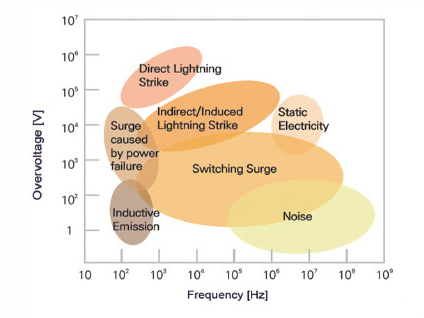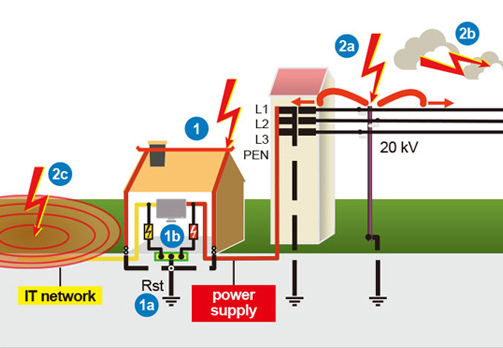Protect your facilities and properties from high energy surges.
It won't be able to expect any satisfactory result and effect with insufficient tools.

Lightning Surge Protection requires certain measures
Protect your facilities and properties from high energy surges.
It won't be able to expect any satisfactory result and effect with insufficient tools.

Comparison between Lightning and Surges with other Various Electromagnetic Hazards
| Type | Typical Applications | Typical Protection Devices Used | Main Selection Criteria |
|---|---|---|---|
| Lightning | Equipment connected to external power and communication lines |
Thyristors, Metal Oxide Varistors, TVS diodes, Gas Discharge Tubes |
Continuous Operating voltage, Residual/ clamping voltage, surge energy/current ratings |
| ESD (Electrostatic Discharge) |
Electronic equipment with a human interfaces and data ports |
Polymer ESD Suppressors, TVS Diode Arrays, Multilayer Varistors(MLVS), LED protectors |
Uni/bi directional, ESD voltage rating, low dynamic resistance, low clamping voltage, capacitance |
| EFT (Electrical Fast Transient) |
Equipment that has, or is connected to, a system or circuit with switched inductive loads or mechanical relays |
Individual TVS Diodes, Metal Oxide Varistors, LED protectors |
Fast rise time response and recovery for repetitive pulses |
| Inductive load switching and commutative spikes |
Equipment associated with large motors, pumps, compressors, relays, and AC power distribution |
Metal Oxide Varistors, TVS Diodes, Gas Discharge Tubes |
Energy/peak current rating, operating voltage, surge current rating |
| Switching / Diversion Current |
Wide range of electrical and electronic circuits | Switching Thyristors, LED protectors | Proper blocking voltage, and current carrying capacity |
Direct lightning disappears from the lightning rod to grounding system, but not 100%.
Approximately 50% of direct lightning enters the building.
